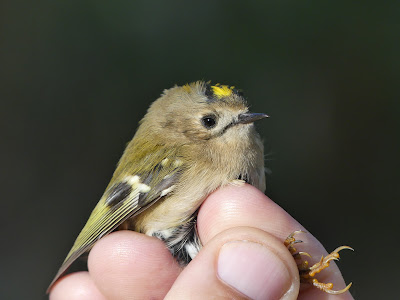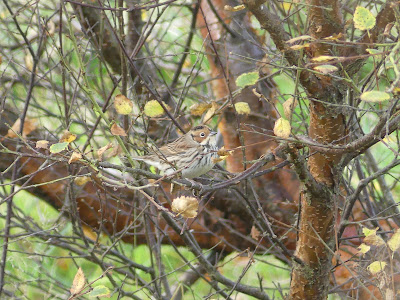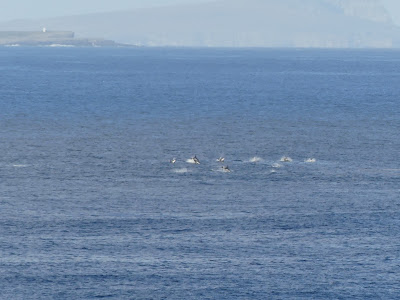We booked this holiday accommodation for two weeks birding, and having booked it were pleased when the owner agreed that we could do some ringing there. We weren't sure how suitable the garden would be but it looked promising from the advertisement.
On arrival we found we were at the very far end of the road with a second empty property next door.
Our house is hidden in the clump of vegetation at the far end of the road.
It was a really nice place to stay. We heard Red Grouse most mornings and saw them a couple of times too. Being in an area by the voeside that was rarely disturbed we were twice able to see otters. There was also an eider flock, with one Velvet Scoter on a couple of dates.
The island is quite striking for three plant species, Montbretia, Fuchcia Riccartonni and Shetland Rose. All are invasive.
Fuchia Riccartonni is extremely hardy and grows freely in gardens and along the burns. Birds eat the seeding fruits and use it for roosting.
The roses plants were a favourite of thrushes and Starlings.
Due to the Gulf Stream bringing warm waters from the Gulf of Mexico through the Atlantic Ocean to the north of the UK, temperatures are warmer than other locations at the same latitude (Alaska, Greenland, Oslo in Norway) and plants continue to flower into October.
We got two nets up in the sheltered front garden with another between the house and hedge of willow and fuchcia at the back. The rear net worked well in the first week, bringing most of the Meadow Pipits that we caught.
Adult Meadow Pipit.
A local man who had heard we were there for the birds came and said that he'd been seeing a bird unlike anything he'd seen before. When a Shetlanders cays that, it's worth paying attention. Unfortunately on this occasion it turned out to be a Meadow Pipit (Hill Sporrow in the local dialect) with partially leucistic feathers in the wings and tail.
Although there were migrants being found, there was little evidence of warblers or flycatchers passing through in the first week. Chris also checked at night with the thermal imager and the garden looked fairly devoid of life, although any birds roosting in the dry-stone walls would not have shown up. We continued targeting Meadow Pipits, and also caught a few of the resident Wrens.
This sub-species of Wren is much more robust than the ones we usually get
at home. Weights for 7 individuals were 14.7g, 13.4g, 12.2g, 14.8g, 13.4g, 12.3g and 12g.
There were Blackbirds foraging in the garden and of those, the later ones were probably migrants as thrushes were beginning to move through.
Another local that we chatted to had got another funny bird, turning out to be a House Sparrow.
Perhaps limited population size, and hence gene pool, causes leucism
in some resident birds
Once the Starlings found the fat pellets we were putting out they visited regularly,
increasingly after nets had been closed.
This net caught most of the Starlings that we got.
There was a second short net in the far righthand corner that was our hope for getting a Yellow-browed Warbler, but despite one on the 2nd and another on the 5th when we were about to leave, we did not catch one.
There was a fall of YBWs on the day we arrived. Other ringers
have colour marked 49 birds on Shetland in the time we were there. Despite seeing
several individuals, none were project birds.
We got a couple of Blackcaps on the last day, both in the rear net where we were no longer getting Mippits.
Female Blackcap
All rings used will be transferred to the local ringing group to maintain a complete record of ringing activities on Shetland.
Total: 56 (8)
Blackbird - 2
Blackcap - 2
Meadow Pipit - 21 (1)
Starling - 22 (4)
Wren - 7 (3)
The house was rented by some birders after us and by their second day had reported 2 Red-breasted Flycatchers.




















































